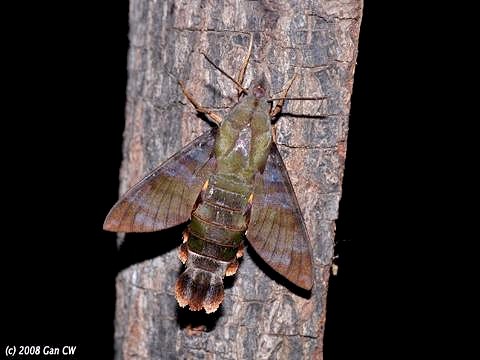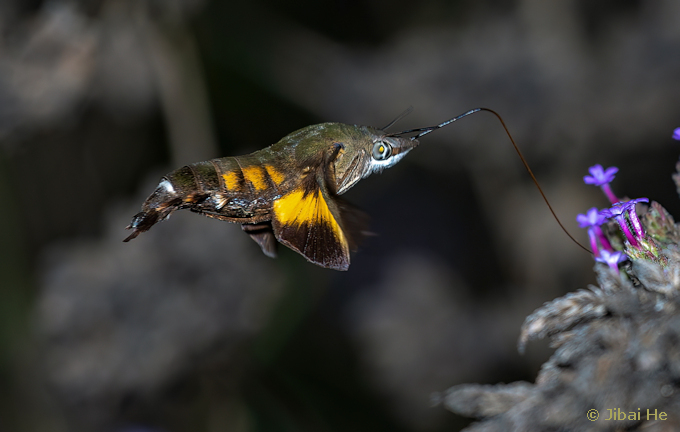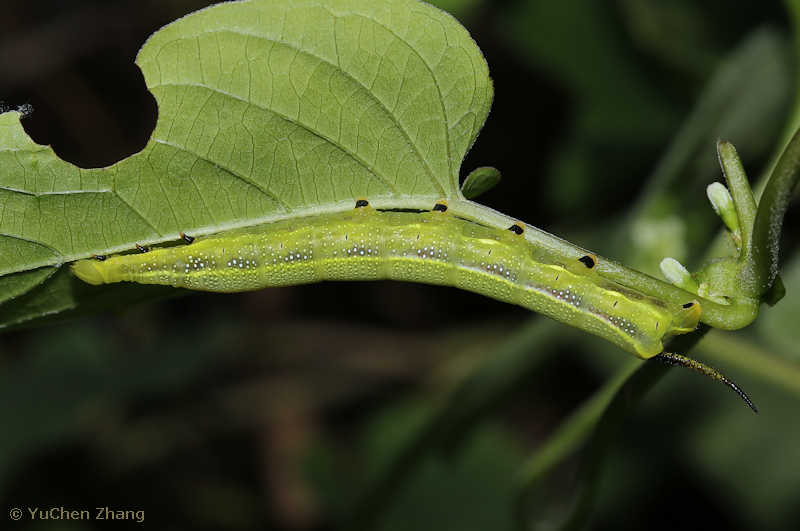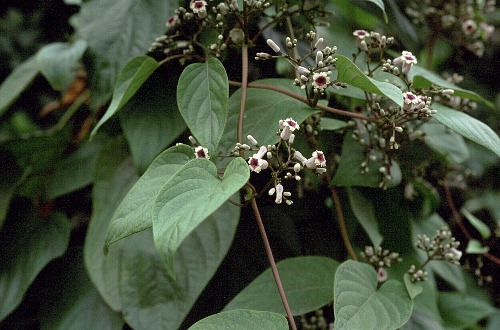


Macroglossum corythus Walker, 1856, List of the specimens of lepidopterous insects in the collection of the British Museum 8: 92. Type locality: Ceylon [Sri Lanka].
Synonym. Macroglossum iwasakii Matsumura, 1921.
Synonym. Macroglossa luteata Butler, 1875.
Synonym. Macroglossum platyxanthum Rothschild & Jordan, 1903.
Note. Macroglossum sylvia Boisduval, 1875, has been synonymized with Macroglossum corythus pylene by Kitching et al., 2018, Biodivers. Data J. 6: e22236. The two syntypes of Macroglossum sylvia were a female from Sulawesi, Indonesia, and a female from Ternate. The former turned out to be a specimen of Macroglossum corythus pseudocorythus, the latter a specimen of Macroglossum corythus pylene. By designating the Ternate syntype as the lectotype, Eitschberger (2018) ensured that the name Macroglossum sylvia sinks into synonymy under the more senior Macroglossum corythus pylene, rather than becoming the valid name for the Sulawesi subspecies of Macroglossum corythus, thereby confirming the synonymy decision of Kitching et al. (2018).
[Further details on this species in Japan, as well as photos of many stages, can be found on Digital Moths of Japan.]
Wingspan: 50--66mm. Fresh, live adults of this species have a beautiful green and violet sheen to the upper surface, which makes them almost glow in sunlight. This fades upon death. Sexually and individually variable in the amount of yellow on body and wings. Head and thorax with a distinctly darker mesial line in fresh specimens; abdomen with three yellow side-patches, variable in size, separate from each other, the first always transverse; anal tuft black, or tawny only at tip. Forewing with the antemedian lines straight, basal area darker than the greyish median interspace, not so dark as in passalus; first and second discal lines rather far apart, very slightly curved; third line vestigial, a grey submarginal space from M1 backwards, often blue in side-light, separated from or almost joined to a small discal costal space of the same colour; no distinctly marked dark subapical spots. Hindwing median band deep chrome, base and distal margin black, inner edge of distal border covered by yellow hairs and scales, median veins more or less black, the yellow band often interrupted, especially in males. Underside of abdomen inclusive of tail dull chestnut-hazel, or deeper brown, side-tuft of third segment white; wings variable, abdominal area of hindwing yellow.
In the male genitalia, tenth tergite truncate or rounded at end; sternite long, sole-shaped, rounded and incrassate at end, upperside transversely carinate, somewhat raised in mesial fine. Valve with friction-scales; harpe long and pointed, reaching nearly to end of valve, differing obviously from that of all other species of Macroglossum. Phallus with two internal rods, one produced into an acute point, the other obtuse; dentate process somewhat variable in length and armature, tip and apical part of distal edge always dentate, proximal edge dentate from base to apex, a number of teeth on phallus near base of process.







Readily attracted to light at night, but active both day and night. Frequents the blossom of Lantana camara, Duranta erecta and Ixora on Hong Kong (Tennent, 1992).
China: v (Hong Kong; Yunnan); v-vii (Hainan); vi (Sichuan); vii (Hubei; Hong Kong; Zhejiang); viii (Guangdong; Hong Kong; Zhejiang); ix (Beijing); ix-x (Hong Kong). Taiwan: vi-vii (Taipei); vii (Tainan Hsien; Pingtung Hsien); x (Kaohsiung). South Korea: 16.viii (South Kyongsang Province). Japan: 26.iii (Ryukyu Archipelago); 17.v (Ryukyu Archipelago); vi-vii (Ryukyu Archipelago); viii (Kyushu; Ryukyu Archipelago); viii-xi (Ryukyu Archipelago); ix (Honshu; Tsushima Island); ix-xi (Ryukyu Archipelago; Kagoshima Pref., Kyushu).
Kendrick (2002) states that it is multivoltine in Hong Kong, occurring from late February until late November, but commonest in October.
In the Ryukyu Islands, commonest between August and October.
OVUM: Pale olive-green, slightly oval (0.85 x 1.00mm), shiny and smooth (Bell & Scott, 1937).
LARVA: Full-fed 70mm, width 10 mm. According to Bell & Scott (1937), in the final instar head round, surface dull, covered with small, sparse, rounded tubercles. Body dull, the same shape as that of M. belis, but horn longer, tapering evenly to a fine rounded point bearing two setae, the whole strongly up-curved, or basal half up-curved, distal half down-curved; closely tuberculate. Segment 2 with a moderately shiny saddle-shaped marking covered closely with large tubercles; anal flap covered sparsely with minute shiny tubercles; rest of body smooth.
Colour individually variable. In one form the head is fuscous-chocolate, vertex and face slightly paler; labrum glassy-greenish; ligula opaque greenish, front edge narrowly white; basal segment of antenna red, other segments ochreous-red; mandible whitish, tip narrowly black. Body fuscous-chocolate with a slight violet bloom, segments 3 to 11 with transverse rows of whitish dots encircling the secondary rings; tubercles on saddle of 2 and anal flap ochreous-brown. There is a dorsal stripe, narrow end black on 2, broader, obscure, purplish-green on remaining segments to base of horn. A narrow, whitish dorso-lateral stripe is also present from 3 to base of horn, clearly defined, but with irregular edges on 3, 4, 11 and 12, suffused with pinkish rust-colour, more or less obsolescent on median segments, often replaced there by an orange shade. Below this stripe a fuscous stripe on which white dots appear clearly on the median secondary rings; a narrow orange supraspiracular and a similar subspiracular stripe, these two stripes joined in the middle of each segment by an orange band, the spiracle lying in the middle of this band. On segments 7 to 11 there are oblique lateral stripes in the form of triangular, enamel-white patches, filling in the angle formed by the hind margin of each segment and the subspiracular stripe. Horn pale brown, the sides of base whitish, the tubercles black. True legs with basal segment shiny black, other segments flesh-colour; proleg with basal half of shank shiny black, distal half shiny ochreous, ankles purplish, feet pinkish-grey; clasper with anterior edge shiny black; venter fuscous-black. Spiracles elongate-oval, central part black bordered with pale brown, the whole with a narrow, shiny pale brown rim (Bell & Scott, 1937).
Another form of the larva is nearly jet-black, the dorsum black, violet, ochreous or rusty; the dorso-lateral stripe is obsolescent except on 2 and 12. The patches round the spiracles are bright orange, the supra-spiracular stripe broad and the same colour; the oblique lateral stripes narrow and occurring on all the body-segments from 2 to 11, or wanting on the anterior segments. In some individuals the spiracular patches are missing. In all these varieties the legs and prolegs are as in the form first described (Bell & Scott, 1937).
The larva, when alarmed throws back the head and anterior segments over the dorsum, and ejects green fluid from the mouth.







PUPA: 31--44mm, width 11mm, cremaster 3 mm. Generally of a bone colour, with a black dorsal stripe on frons and on thorax. Median line of tongue-case fuscous ventrally. Tongue-case, wing case, legs, antenna and tongue marked with leaden-grey transverse lines and bands. Dorsum of abdomen with a russet tinge and an obscure dark dorsal stripe. There are broad, broken, fuscous, lateral, ventral and ventro-lateral stripes. The spiracles are black, the abdominal pitting and cremaster russet. Tongue-case well developed; tip of tongue spatulate. Antenna equal to fore leg; with a short, narrow coxal piece. Surface slightly shiny; head and wing-case smooth, edge of tongue-sheath longitudinally grooved. Thorax obscurely corrugate. Abdomen more strongly corrugate and also marked with small pits; hind bevels of segments 8 to 10 with a row of small pits along their front margins; front bevel of 9 with a wide channel set with minute tubercles along its front margin, the rest of its surface set with prominent oval tubercles decreasing in size from the channel to the hind margin of the bevel. Spiracle of 2 a narrow slit, the hind margin of 2 shallowly emarginate and slightly raised in front of it, a narrow transverse oblong lobe projecting from the front margin of 3 behind it, the front edge of lobe prominently raised, the hind edge deeply depressed. Other spiracles oval, the surface rising gradually to a smaller convex oval containing the central slit, which has narrow, raised edges. Cremaster large, triangular, broadly truncate, a minute tooth at each lateral angle of the truncation. Upper surface smooth and shiny, basal two-thirds convex, distal third flat, lower surface hollowed, basal one-quarter broadly keeled, and with lateral extensor ridges nearly meeting based (Bell & Scott, 1937).



Larval hostplants. Paederia foetida (Rubiaceae) in Hong Kong (Kendrick, 2002) and Beijing (Xu ZhenBang, pers comm. 2022), as well as Okinawa, Japan (Tanahara, 2015). Morinda citrifolia and Strychnos nux-vomica in southern India, Paederia foetida in northeastern India (Bell & Scott, 1937), and Guettarda elsewhere.

China: Beijing (Beijing Botanical Garden); Anhui (Anqing); Zhejiang (Nanji Islands National Nature Reserve, Wenzhou; Tianmu Shan; Hangzhou); Hubei (Changyang); Sichuan (Baoxing; Pengshui); Chongqing (Fengjie); Yunnan (Simao/Pu'er); Xizang/Tibet (??Chápà); Hunan (Zhuzhou); Jiangxi; Fujian; Guangdong (Longtou Shan); Hong Kong; Hainan (??Secha; Chengmai).
Taiwan: Taipei (Neihu); Taipei Hsien (Fushan); Tainan Hsien (Kuantzuling, 1000'); Pingtung Hsien (Kenting); Kaohsiung.
South Korea: South Kyongsang Province (Chukdong-myeon, Sacheon-si).
Japan: Tsushima Island (Tsutsu) (Yoshiaki Sakai, pers. comm 2005); Kyushu (Hashima-zaki, Kagoshima Prefecture; Naze; Nishinakama) (Nicho, 2014); Ryukyu Archipelago (Okinawa (Yonabaru + Nago + Shuri + Naha + Chinen + Izumi + Nakijin + Yoni); Tokuno-jima; Ishigaki-jima; Oshima Island; Kuba-jima; Kuro-jima; Iriomote-jima).
The late flight-times and limited number of records for Japan (Nicho, 2014) indicate that this species may only be a late summer migrant to Tsushima Island, Kyushu and the Ryukyu Archipelago.
Bhutan (Irungbam & Irungbam, 2019), northeastern India, Bangladesh, Andaman and Nicobar Islands, Thailand, eastern and southern China, Taiwan, South Korea (Choi, Kim & Jeon, 2020), Japan (Tsushima Island; Kyushu; Ryukyu Archipelago), Vietnam (Le & Vu, 2024), Malaysia (Peninsular, Sarawak, Sabah), Indonesia (Sumatra, Java, Kalimantan, Flores, Sumba, Sulawesi), the Philippines (Palawan, Mindanao, Luzon).

 Return to Sphingidae of the Eastern Palaearctic species list
Return to Sphingidae of the Eastern Palaearctic species list